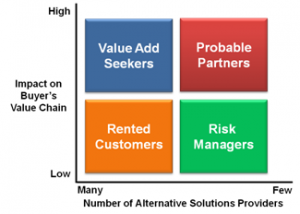
Every salesperson has a territory. Whether that “territory” is defined by geography or demography, horizontally or vertically in terms of market segmentation, or by product, sales people need to be able to prioritise their prospects and their prospecting activities and efforts. We only have a finite time everyday to find and make sales. If we are clear about what we offer, how it is of value to our clients and know where and how we find these prospective buyers, selling and buying is much easier. An important skill for all salespeople is to learn to identify different buyer profiles. This knowledge helps sales people fast-track their position with key decision makers and influencers. Categorising decision-makers and buying influencers enables sales people to put the right emphasis on the value offered and as a consequence they optimise the use of time. This ensures that sales people don’t ignore (and potentially alienate) important client decision makers and buying influencers. When we look at a ‘sales territory’ we need to look at key criteria about our market first:
- Impact on the Buyer (personally or across the value chain) – what is the impact of our offering on the buyer? It will range from high impact to low impact.
- Number of alternative Solution Providers (competitors): how many competitors are competing for your buyer’s attention? Many or few?
As illustrated by the diagram here we plot the ‘Impact on the Buyer’ and Number of Alternative Solution Providers’ on a graph.  Now we can prioritise and map the different types of buyers we may encounter in our ‘Sales Territory’. Within your given sales territory there are generally four types of prospective buyers:
Now we can prioritise and map the different types of buyers we may encounter in our ‘Sales Territory’. Within your given sales territory there are generally four types of prospective buyers:
- Rented Customers: To these prospects the purchase is “nice to have” but not necessarily essential – because the impact on the buyer is low. In addition, they have many alternatives to pick from so they are likely to want lower prices, quick delivery and uncomplicated solutions.
- Value Add Seeker: These prospects have the upper hand in negotiating because of the amount of alternatives they have available to them for the purchase decision they want to make. The advantage you have is that they really need your solutions.
- Risk Manager: These prospects are concerned about the reputation and reliability of the supplier they choose. Because the purchase has low impact on them they can afford to take time and shop around until they find the kind of solution they want, at a price they are comfortable with. They may even go without a solution.
- Real Partners: The importance of the purchase to the buyer and the fact that there are not too many options open to them are some of the reasons why these buyers look for preferred suppliers with whom they want to form long-term relationships.
Determining the different types of prospective buyers helps sales people work smarter because it allows us to focus more effectively on how we need to work with buyers, how best to position what we have to offer and how to prioritise our time and activities. In sales, being able to prioritise who you are going to work with and how you are going to work with them is very important. Selling requires constant prioritising. Remember everybody lives by selling something. Author: Sue Barrett, www.barrett.com.au


New Article Email Notification